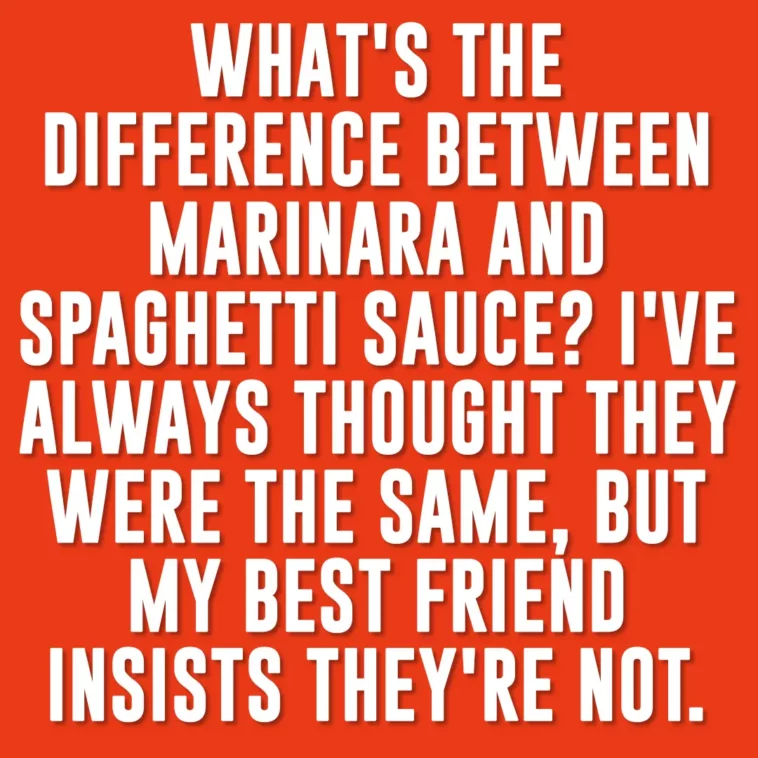Marinara vs. Spaghetti Sauce: What’s the Real Difference?
If you’ve ever stood in your kitchen, holding a jar of marinara in one hand and spaghetti sauce in the other, wondering if there’s really a difference—you’re not alone. These two sauces look similar, smell delicious, and are both tomato-based, so it’s easy to mix them up. But ask any passionate home cook or Italian food lover, and they’ll tell you there is a difference. Let’s break it down together and explore what sets them apart—from their history and ingredients to how they’re best used in your favorite dishes.
Contents
- 1 What Exactly Is Marinara Sauce?
- 2 Where Did Marinara Come From?
- 3 The Flavor and Feel of Marinara
- 4 How to Make Authentic Marinara at Home
- 5 So, What’s Spaghetti Sauce Then?
- 6 The Many Faces of Spaghetti Sauce
- 7 What Goes Into Spaghetti Sauce?
- 8 Cooking Spaghetti Sauce the Traditional Way
- 9 Marinara vs. Spaghetti Sauce: What’s the Real Difference?
- 10 Why People Get Them Mixed Up
- 11 When to Use Each Sauce
- 12 So, Which One’s Better?
What Exactly Is Marinara Sauce?
Marinara is a classic Italian tomato sauce known for its simplicity and fresh flavor. It’s usually made with just a few ingredients—ripe tomatoes, garlic, herbs (like basil and oregano), and a splash of olive oil. That’s it! No meat, no fuss—just clean, bright flavor. It’s often used as a base for pasta, pizza, or even as a dip for things like mozzarella sticks or garlic bread.
Where Did Marinara Come From?
Marinara sauce has roots in Naples, Italy, and despite the name sounding like it should include seafood (since marinaro means “sailor-style”), it doesn’t! It was traditionally made by sailors using ingredients that wouldn’t spoil easily while out at sea. This makes sense when you think about how simple and shelf-stable the ingredients are—no refrigeration required, even back in the 1500s when tomatoes first made their way to Europe.
The Flavor and Feel of Marinara
Marinara has a fresh, slightly tangy taste with the natural sweetness of tomatoes shining through. Garlic adds a little kick, and herbs bring that comforting Italian aroma we all know and love. Because it isn’t loaded with extra ingredients or meat, marinara is light, bright, and perfect when you want something fresh and not too heavy.
How to Make Authentic Marinara at Home
Making marinara from scratch is super easy and doesn’t take much time. Start by sautéing garlic in olive oil, then add peeled and crushed tomatoes. Simmer it just long enough for the flavors to come together—maybe toss in a few red pepper flakes or a splash of wine if you’re feeling fancy. The key is not to overcook it; you want that fresh tomato flavor to stay front and center.
So, What’s Spaghetti Sauce Then?
“Spaghetti sauce” is more of a catch-all term. It’s basically any tomato-based sauce served with spaghetti—and that includes the rich, meaty sauces we often think of, like Bolognese or ragu. While it can be as simple as marinara, spaghetti sauce is usually heartier, packed with ingredients like ground beef, sausage, mushrooms, onions, and peppers.
The Many Faces of Spaghetti Sauce
Over time, spaghetti sauce has evolved into all sorts of delicious variations. Some are thick and meaty, while others might include a splash of cream, a load of veggies, or a long list of herbs and spices. It’s all about personal taste and regional preferences. That’s why no two spaghetti sauces taste quite the same!
What Goes Into Spaghetti Sauce?
At its core, spaghetti sauce starts with tomatoes. But beyond that, it often includes sautéed onions and garlic, ground meat, bell peppers, and a mix of Italian herbs like basil, oregano, and thyme. It’s typically simmered for a long time—sometimes hours—to develop that rich, savory flavor that clings perfectly to pasta.
Cooking Spaghetti Sauce the Traditional Way
To get that deep, comforting flavor, many cooks begin by browning the meat with onions and garlic before adding tomatoes and seasonings. The longer it simmers, the better it gets. It’s a labor of love, and the reward is a sauce so rich and hearty it can turn a simple bowl of spaghetti into something magical.
Marinara vs. Spaghetti Sauce: What’s the Real Difference?
While both sauces start with tomatoes, the difference lies in complexity. Marinara is quick, light, and fresh—perfect for when you want something simple and bright. Spaghetti sauce, on the other hand, is often slow-cooked, rich, and packed with bold flavors. Think of marinara as a weeknight go-to and spaghetti sauce as your Sunday supper favorite.
Why People Get Them Mixed Up
It’s easy to see why these sauces get lumped together—they share the same red hue and tomato base. But just like there’s a difference between a light summer salad and a hearty stew, these sauces each have their own personality. Sure, you can substitute one for the other in a pinch, but knowing the difference helps you get the flavor and texture you’re craving.
When to Use Each Sauce
Marinara is wonderful for lighter dishes—angel hair pasta, seafood, pizza, or even as a dipping sauce. Spaghetti sauce shines in heartier meals like lasagna, baked ziti, or a big bowl of spaghetti and meatballs. Choosing the right sauce can take your meal from good to unforgettable.
So, Which One’s Better?
There’s no real winner here—just different vibes for different dishes. Marinara is all about clean, simple elegance. Spaghetti sauce brings comfort and richness to the table. Once you understand what makes each sauce special, you can use them with confidence and maybe even impress a few dinner guests along the way!
Want to try both? Why not! Each sauce brings its own magic, and having both in your kitchen repertoire is a delicious idea.




